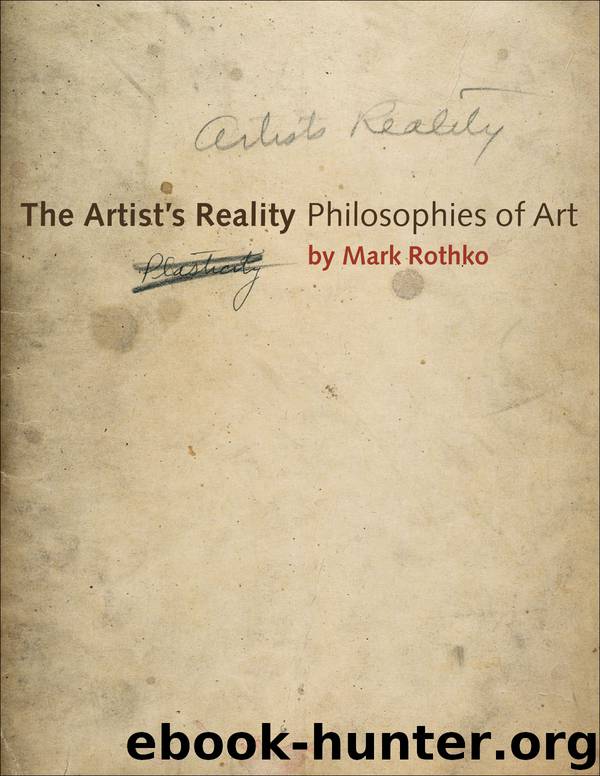The Artist's Reality by Mark Rothko

Author:Mark Rothko
Language: eng
Format: epub
Publisher: Yale University Press
Published: 2004-02-27T16:00:00+00:00
BEAUTY: PLASTIC AND ILLUSORY
Now what kind of stimulus is afforded us by each of the two types of plasticity, illusory and tactile? We have already said that each is devoted to the manifestation of an ideal through a related movement within the canvas. This ideal we have now is called beauty. We must then ask how to receive the sense of beauty from the illusory painting and from the tactile painting, and in what way they differ.
Let us first take the case of the illusory painting. This, as we have already stated, is committed to the reproduction of appearances. Even imaginary situations must appear to us as they would visually if they were actually in existence. Our whole reference here is to the sense of vision alone. Therefore the artist must either have the model before him or imagine the visual model for his painting so concretely that the painting itself is a reproduction of what is seen either in nature or in the mind.
For the sake of illustration let us assume that a portrait is being painted. Our sense of beauty in relationship to the portrait must come from the thing described in the painting, rather than from the likeness of the model. Of course, we can derive certain pleasure from the excellence of execution and the facility of technique, but we have already concluded that beauty does not depend upon this and that it demands only that the technique be adequate for presentation. To state this more pertinently, we might say that the less we are conscious, particularly in the case of illusory painting, of the necessarily artificial methods of achieving the illusion of this visual reality, the greater the conviction we will have in this reality.
Now if this painting is, let us say, of a woman, our sense of beauty would be satisfied if the woman in the picture were beautiful. In other words, what we enjoy in the picture is the notion of a beautiful woman. The picture here participates with us in our ideal of feminine beauty and our reference is the ideal that we have in common with the artist of what makes a woman beautiful. For corroboration of the existence of that ideal, we have moving pictures and theaters, both of which present a pretty good notion of the common denominator of visual beauty in women, which is attested to by their box office returns. There are women on the stage, of course, who are not beautiful but who are there because they are good actresses. The distinction between these two types of actresses, however, is very clearly made.
Of course, not only this idea of pulchritude exists. Certain features give a sense of refinement of character. This, of course, the sensitive illusory artist would also try to include in his presentation, his object being to portray the visual attributes of these qualities. “Naught but the fair can dwell in such a temple” (to paraphrase the bard), is the basis of his representation. If
Download
This site does not store any files on its server. We only index and link to content provided by other sites. Please contact the content providers to delete copyright contents if any and email us, we'll remove relevant links or contents immediately.
Ways of Seeing by John Berger(1296)
The Perfumes The A-Z Guide by Luca Turin(1102)
Rembrandt Drawings by Rembrandt(1092)
The Hare with Amber Eyes by Edmund de Waal(1077)
It's Never Too Late to Begin Again by Julia Cameron(983)
On Photography by Walter Benjamin(931)
Natasha's Dance by Orlando Figes(898)
A Month in Siena by Hisham Matar(868)
Why Architecture Matters by Paul Goldberger(827)
The Sound of Paper by Julia Cameron(817)
Minor Feelings by Cathy Park Hong(817)
The Selected Poetry of Rainer Maria Rilke by Rainer Maria Rilke(816)
0062259628 by Sarah Strohmeyer(815)
0544325265 by Brendan Jones(800)
Citizen: An American Lyric by Claudia Rankine(783)
Proust Was a Neuroscientist by Jonah Lehrer(769)
The Death of the Artist by William Deresiewicz(766)
Perfumes the Guide 2018 by Luca Turin(754)
And Our Faces, My Heart, Brief As Photos by John Berger(725)
